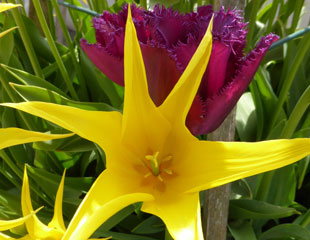
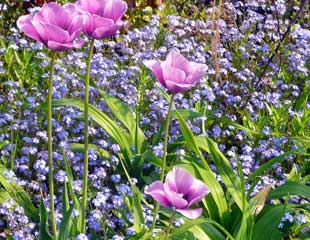
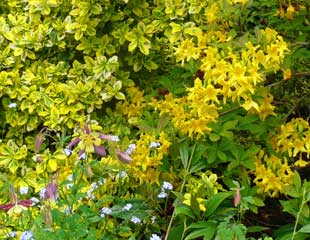
Spring planting ideas
There are many easy to grow garden favourite plants which make colourful borders and are readily available in garden centres and on line. Every garden and gardener is different; it's a pick and mix of spring flowering plants.
Ideas for summer planting combinations

Aquilegia 'Swan-Lavender' with Euonymus fortunei Emerald Gold and Rhododendron luteum.
This is a lovely spring combination, Aquilegia 'Swan-Lavender' with Euonymus fortunei Emerald Gold and Rhododendron luteum. This planting combination creates a bright yellow splash in the border and these plants are easy to grow.
Aquilegia, common name columbine, is a herbaceous spring perennial with delicate flowers. Check out growing Aquilegia to truly appreciate its beauty, as the image doesn't do it justice. Euonymus is a common garden shrub, which means it can get overlooked, but many varieties have strong variegated leaves. It is evergreen and fully hardy.
The Rhododendron in this planting combination is deciduous but has the bonus of being scented. Like all Rhododendrons, it needs acid soil to thrive.
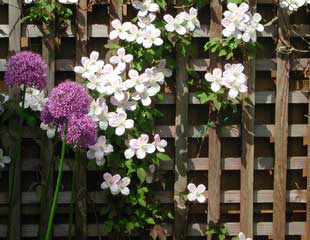
Clematis planting combinations
Clematis look good with so many plants in combinations, and also on their own as a specimen plant, but they are not the easiest of plants to grow. For detailed advice on planting, growing and pruning clematis. The image left shows the early flowering Clematis montana with spring flowering Alliums.
Clematis montana is one of the easier clematis to grow because it only needs pruning when it has grown too large. Unlike the group 2 & 3 clematis C. montana does not need regular pruning, so if you don't enjoy pruning, this is the Clematis for you.
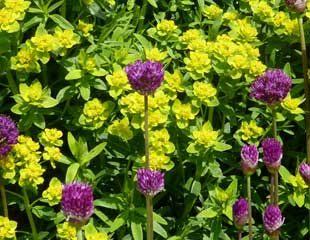
Alliums look fabulous with many spring flowers, as the following images show. Alliums are easy to grow and once planted, they will come up reliably each year.
In the image Allium hollandicum 'purple sensation' is planted with Euphorbia palustri a strong combination of lime green and purple.
If you have a big space here is a bold spring planting idea

This is a combination of blossom trees, Betula utilis jacquemontii - West Himalayan Birch and a great display of spring bulbs. This image was taken at Stoke Albany House, an NGS garden and looked just stunning.
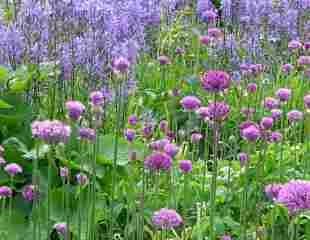
Planting combination Allium with Camassia
In this image, a different type of effect is obtained from planting Allium with Camassia creating a haze of soft blue and purple. Camassia is also a bulb, tolerant of most soils, including damp soil, and they will tolerate partial shade.
The only drawback is that they are ** hardy so many not survive a bad winter and are best with a good mulch before the cold weather.
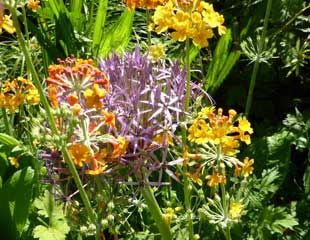
Spring Planting combination Allium christophii and primula 'Harlow carr'
Still with Alliums, this combination is allium christophii and primula 'Harlow carr'. A combination of the Allium spiky flower head which looks stylish together with the yellow, red and orange hues of Primula 'harlow car'. Both are easy to grow and look lovely in the spring border. Primula is a wide-ranging group of plants and worth checking out. They are long flowering and come in many colours and sizes; the Harlow carr varieties are especially nice, a tall candelabra variety.
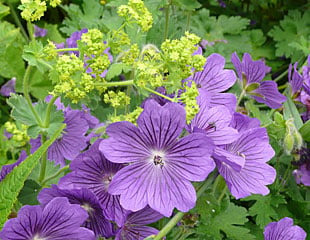
Plant combinations Geranium (Cranesbill) and Alchemilla mollis (Lady's Mantle)
An easy combination of plants, both of which are perennial and fully hardy. A contrasting combination of purple and lime green. The purple flower is a hardy Geranium, which will grow in most soil conditions, including light shade. Tips and growing information on Geraniums.
The lime green is Alchemilla mollis, again easy to grow, possibly too easy as a bit of a self seeder, but equally easy to remove where it is not wanted. Further growing information on Achemilla.
